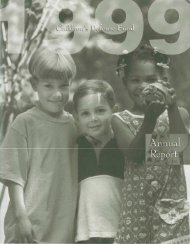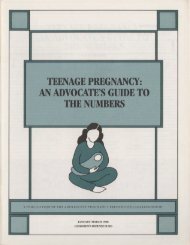child care - Digital Library Collections
child care - Digital Library Collections
child care - Digital Library Collections
You also want an ePaper? Increase the reach of your titles
YUMPU automatically turns print PDFs into web optimized ePapers that Google loves.
THE STATE OF AMERICA'S CHILDREN YEARBOOK 1998<br />
"---...;;...;;,;;..;;.<br />
Spotlight on Employment Opportunities for Youth<br />
In 1997 the national unemployment rate dropped to less than 5 percent, but the unemployment<br />
rate for teenagers was three times as high. Those with jobs typically receive meager<br />
earnings and few opportunities to move up the economic ladder. As a result, too many young<br />
people see little reward for avoiding high-risk behaviors that lead to criminal activity, drug abuse,<br />
and teen pregnancies.<br />
Unfortunately, for the past 25 years the employment and economic prospects of teenagers<br />
and young adults have steadily worsened. Changes in our economy have made it increasingly<br />
difficult for young people with little education or training to gain a foothold in the labor market.<br />
At the same time, the economic return for their labor has diminished. Part ofthe solution to the<br />
problems engulfmg so many teenagers and young adults lies in job opportunities that will help<br />
them break free of their bleak environments. The transition into adulthood is trying enough;<br />
without hope, it is fraught with even greater perils. Young Americans need to believe that if they<br />
work hard, get an education, and invest in their own futures, they will reap rewards.<br />
Persistent unemployment and wage decline for young people. In November 1997 the jobless<br />
rate for all Americans feU to 4.6 percent-the lowest in 25 years. Meanwhile, the unemployment<br />
rate for workers ages 16 to 19 remained essentially unchanged at 15.0 percent-three times the<br />
general rate. Among Hispanic teenagers unemployment reached 15.9 percent; among Black<br />
teens, 28.6 percent. The job market was tight for young adults as well, with one of every 12<br />
Americans between the ages of 20 and 24 (8.4 percent) out of work.<br />
Dropping out of school is a sure path to unemployment or low wages. According to data<br />
from the U.S. Bureau of Labor Statistics, of the nearly half-million high school dropouts in<br />
1995-96, 286,000 had no job in October 1996. Not all these young people were in the labor<br />
force (that is, working or actively seeking work), but among those who were, the unemployment<br />
rate was 27.9 percent. This average masks disparities by gender and race: unemployment among<br />
high school dropouts stood at 31.1 percent for males, 21.8 percent for females, 25.3 percent for<br />
Whites, 42.5 percent for Blacks, and 19.7 percent for Hispanics.<br />
High school graduates also had a difficult time finding work. Of the 931,000 graduates in<br />
1995-96 who did not go on to college, 382,000 were without jobs in October 1996. About 25<br />
percent of those in the labor force were unemployed, although jobless rates for minorities were<br />
considerably higher: 44.8 percent for Black high school graduates and 36.1 percent for Hispanics,<br />
compared with 19.3 percent for Whites.<br />
Even for those who fmd work, income has fallen. Using the U.S. Census Bureau's Historical<br />
Income Tables, CDP calculated that for 18- to 24-year-old high school dropouts with full-time,<br />
year-round employment, earnings (measured in 1996 dollars) plunged 25.1 percent between<br />
1974 and 1996 (27.4 percent for males and 11.3 percent for females). Workers who have<br />
completed high school typically fare better than dropouts, but a high school diploma is no<br />
longer a ticket to economic security. Earnings (again measured in 1996 dollars) for 18- to<br />
24-year-old graduates who hold full-year, full-time jobs and have no postsecondary education fell<br />
15.9 percent between 1974 and 1996 (20.0 percent for males and 12.1 percent for females).<br />
This feature was prepared in cooperation with Alan Zuckerman, executive director ofthe National Youth<br />
Employment Coalition.<br />
88 CHI L D R EN'S D E FEN S E FUN D














